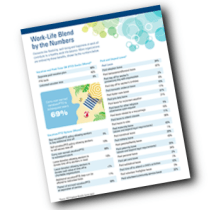
Work-life balance is an idea that’s been tossed around for decades, and organizations have paid a lot of attention to the term, particularly over the last three years as the line between work and life has blurred. But the term work-life blend may be a more accurate description of what workers want—reflecting their desire to improve multiple facets of their lives.
While it may seem nearly impossible to achieve a true equilibrium between work and life, organizations can take steps to help their workers feel more blended, leading to increased happiness at work and ultimately higher retention rates and productivity. Work-life blend covers a wide gamut of considerations, but plan sponsors can start by examining these three areas:
- Flexibility: Work-life blend can mean different things for different people, so talk to your plan participants to get a sense of what types of flexibility they may want so you can make meaningful changes. While working from home or a four-day workweek isn’t possible for every organization, maybe there are other accommodations that make sense while providing added flexibility.
- Well-being: Workers can be their best selves both at work and at home when benefit offerings support the full circle of mental, physical and financial health.
- Happiness at work: Employers influence happiness by making employees feel valued, recognized and included, ensuring that the workplace or jobsite culture is free of bullying and harassment while building and celebrating inclusivity.

National Employee Benefits Day (NEBD) is coming up on April 6, and this year’s theme is work-life blend. NEBD is a perfect time for benefits professionals to take a step back, look at the big picture, and take advantage of new resources for plan participants and beneficiaries. Head out to ifebp.org/benefitsday for more tools on building a better work-life blend and what that means for different organizations. Resources include:



Resources include:




